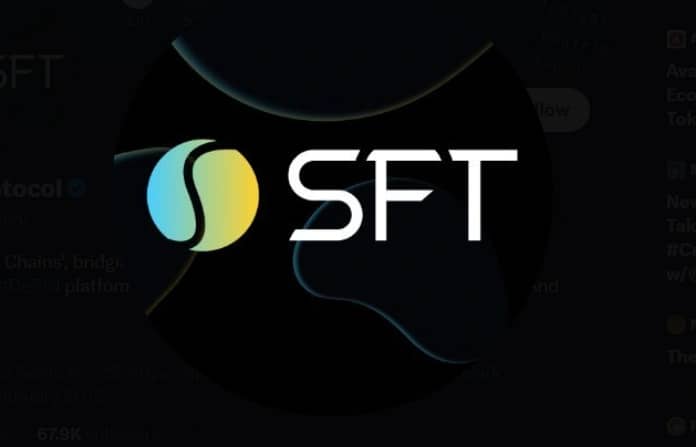Subscribe to wiki
Share wiki
Bookmark
SFT Protocol
The Agent Tokenization Platform (ATP):Build autonomous agents with the Agent Development Kit (ADK)
SFT Protocol
The SFT Protocol is a decentralized platform designed to bridge physical infrastructure with Web3 technologies, creating a comprehensive Decentralized Physical Infrastructure Network (DePIN). It aims to integrate various hardware and data services into a single decentralized autonomous organization (DAO), addressing the growing demand for computational resources in emerging technologies. [1][3][5]
Overview
The SFT Protocol is built on the concept of a "Chain of Chains," serving as a marketplace for transactions using coins from various blockchain networks. Its primary goal is to create a sustainable and flexible framework for integrating diverse hardware and data services. The protocol utilizes an auction system to ensure continuous and organic growth, while also providing revenues to stakeholders and the DAO. [2]
The SFT protocol is a decentralized protocol for providing liquidity for staking assets and for building high-performance public chain cloud nodes. Aside from providing privacy computing and distributed storage capabilities, it is also a platform provider. [5]
Key features of the SFT Protocol include:
- Liquid staking derivatives for long-term locked assets
- Wrapped coins from integrated chains
- Full-node RPC services
- Decentralized storage, bandwidth, and computing
- AI computing services
- GPU rendering (public and private)
- Encrypted and validatable data collection from IoT and other sources
Chain of Chains
The "Chain of Chains" concept refers to a distributed network that acts as a marketplace for transacting with various coins across different blockchain networks. It uses an auction system to facilitate organic growth, integrate diverse hardware types, and maintain revenue stability. [2]
Initially, it focuses on liquid staking derivatives and revenue generation, with plans to expand into on-chain services like storage and RPC, and eventually off-chain services such as AI compute. The goal is to create a sustainable, decentralized global investment and infrastructure platform. [2]
DePIN
The SFT Chain and the DePIN network it builds aim to break the tradition of Web2-based businesses and facilitate organizational and community developers in building applications based on Web3 in order to achieve diversity of SFT Chain devices, enable blockchain-based ownership management and off-chain SFT Chain data processing and storage, etc. [2]
Core Components
DAO Smart Contract
The DAO serves as the governing body of the protocol, responsible for owning the treasury and receiving proceeds, voting on new projects, partners, integrations, and proceed distribution, and staking/ governance mechanisms for DAO token holders. [4]
Liquid Staking Derivatives and Wrapped Coins
The protocol supports LSD tokens for integrated staking networks (e.g., SFT for Filecoin) and wrapped tokens from other blockchains (e.g., Bitcoin). [4]
Liquidity Bond Auctions
A portion of hardware proceeds is auctioned off in exchange for liquidity provider (LP) tokens. This mechanism ensures healthy organic growth of the protocol and facilitation of LSD, wrapped, and DAO token functionality. [4]
Decentralized Hardware Ownership
The protocol incorporates three models for hardware ownership:
- Direct Model: Uses service provider contracts for colocated equipment in existing data centers
- Distributed Model: Integrates partner services and networks
- Decentralized Model: DAO-owned nodes on its own Layer 1 blockchain[4]
Products
Staking
The Stake contract section is built on the FEVM and BSC networks, offering entry points for fixed-term farming and liquidity pool deposits, and displaying on-chain and section-specific earnings data. By selecting the fixed-term farming entry, users can complete FIL deposits, SFT minting, and fixed-term deposits in one click, earning FIL and rewards in rSPD. Selecting the liquidity pool entry (FEVM only) allows users to deposit FIL, immediately mint rSFT to their wallet, and earn liquidity pool rewards. [10]
Farms
SFT Farms is a system where cryptocurrency holders can pool their funds with other users to pursue investment returns. It offers the following products: SFT Fixed Deposit, Stake Raydium-LP, Stake rSFT, Stake LP, and Stake Sushi-LP. Users can earn returns by staking token certificates through the protocol. [11]
Pools
The Pool contract module is built on the FEVM network and serves various functions within its "flywheel" economic system. Users can borrow FIL to support SFT farms, provide bridge funds for the redemption of fixed-term farms, contribute FIL to liquidity pools and earn rewards, and deposit the earnings generated from LP staking into the Pool. [12]
DePIN
The DePIN section aims to integrate early-stage testnet public chain projects, built on Solana and FEVM networks. Investors participate by using rSPD, and upon mainnet launch, they receive additional rewards. All rSPD used for participation will be burned. [13]
Bridge
This decentralized cross-chain bridge facilitates the transfer of tokens like SFT, rSPD, etc., to target addresses on the Solana, FEVM, and BSC networks. During cross-chain transactions, a fee of 5 rSPD is levied, and this fee is entirely burned. [14]
Team
See something wrong?
The Agent Tokenization Platform (ATP):Build autonomous agents with the Agent Development Kit (ADK)
